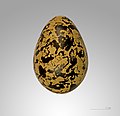Greater painted-snipe
| Greater painted-snipe | |
|---|---|

| |
| Male on water | |
| Scientific classification | |
| Kingdom: | Animalia |
| Phylum: | Chordata |
| Class: | Aves |
| Order: | Charadriiformes |
| Family: | Rostratulidae |
| Genus: | Rostratula |
| Species: | R. benghalensis
|
| Binomial name | |
| Rostratula benghalensis | |

| |
| Distribution. | |
| Synonyms | |
| |
The greater painted-snipe (Rostratula benghalensis) is a species of wader in the family Rostratulidae. It is found in marshes in Africa, South Asia and South-east Asia.[2]
Description[]

Medium-sized, plump wading bird. Long reddish-brown bill, slightly decurved at tip, and distinct white or pinkish eye patch. Rounded, buff-spotted wings and short tail. White of breast extends up around top of folded wing. The painted-snipe is not related to the true snipes and differs from them in habits, flight and appearance, being far more colorful and having longer legs than the snipes. It is unusual in that the female is larger and more brightly colored than the male, with the sides of the head, neck and throat a rich chestnut brown, and a distinct black band across the breast; the male is paler and greyer.
Behaviour[]
Not a vocal species; the male at times utters a shrill trill, while the female makes a guttural ook sound as well as hissing noises during breeding displays.
Usually found close to the fringes of reed beds along shorelines of marshes, swamps, ponds and streams.
Solitary or in pairs, sometimes in groups of up to 12. Rather shy and retiring, skulking close to the vegetation so that it can retreat to cover if disturbed. When flushed, flies like a rail with legs dangling. Bobs hindquarters on landing and sometimes when walking. Probes for food in the mud. The female initiates courtship and may mate with more than one male. The male incubates the eggs and takes the parental care.
Food and feeding[]
They feed on insects, crustaceans, molluscs and seeds.
Reproduction[]
The females court the males, are polyandrous[3][4] with males incubating and raising the young as predicted by parental investment theory. Chicks are buff coloured and have black stripes running along their length.[5] Immature birds resemble the male but lack the broken dark band across the breast. Males are also known to carry the chicks to safety under the wings.
The nest is usually a shallow scrape in soft ground, lined with plant material and situated among grass or reeds at the water's edge; sometimes a pad of vegetation or a nest of grass and weeds. The breeding season is between April and July.
Gallery[]

Egg of Rostratula benghalensis – Muséum de Toulouse, France

Female in flight – Manjira Wildlife Sanctuary, Telangana, India

Closer view of a female – Kruger National Park, South Africa

Male with chicks - Hong Kong, China
References[]
- ^ BirdLife International (2016). "Rostratula benghalensis". IUCN Red List of Threatened Species. 2016: e.T22735810A95118332. doi:10.2305/IUCN.UK.2016-3.RLTS.T22735810A95118332.en. Retrieved 12 November 2021.
- ^ "Rostratula benghalensis (Greater Painted-snipe) - Avibase". avibase.bsc-eoc.org. Retrieved 2017-10-16.
- ^ Shigemoto Komeda (1983). "Nest Attendance of Parent Birds in the Painted Snipe (Rostratula benghalensis)". The Auk. 100 (1): 48–55. doi:10.1093/auk/100.1.48.
- ^ Wesley, HD (1993). "Breeding behaviour sequential polyandry and population decline in (Rostratula benghalensis)". In Verghese, A; Sridhar, S; Chakravarthy, AK (eds.). Bird Conservation: Strategies for the Nineties and Beyond. Ornithological Society of India, Bangalore. pp. 166–172.
- ^ Wesley, H Daniel. "A male painted snipe and his chick". Newsletter for Birdwatchers. 30 (7&8): 3.
External links[]
- (Greater) Painted snipe - Species text in The Atlas of Southern African Birds
- BirdLife Species Factsheet.
| Wikimedia Commons has media related to Rostratula benghalensis. |
- IUCN Red List least concern species
- Rostratula
- Birds of Africa
- Birds of East Asia
- Birds of South Asia
- Birds of Southeast Asia
- Birds described in 1758
- Taxa named by Carl Linnaeus




